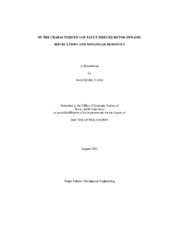| dc.description.abstract | Rotor-dynamic stability is a very important subject impacting the design, control, maintenance, and operating safety and reliability of rotary mechanical systems. As rotor-dynamic nonlinearities are significantly more prominent at higher rotary speeds, the demand for better and improved performance achievable through higher speeds has rendered the use of a linear approach for rotor-dynamic analysis both inadequate and ineffective. To establish the fundamental knowledge base necessary for addressing the need, it is essential that nonlinear rotor-dynamic responses indicative of the causes of nonlinearity, along with the bifurcated dynamic states of instability, be fully characterized. The objectives of the research are to study the various rotor-dynamic instabilities induced by crack breathing and bearing fluid film forces using a model rotor-bearing system and to investigate the applicability of the fundamental concept of instantaneous frequency for characterizing rotor-dynamic nonlinear responses. A comprehensive finite element model incorporating translational and rotational inertia, bending stiffness and gyroscopic moment is developed. The intrinsic modes extracted using the Empirical Mode Decomposition along with their instantaneous frequencies resolved using the Hilbert transform are applied to characterize the inception and progression of bifurcations suggestive of the changing rotor-dynamic state and impending instability. The dissertation presents and demonstrates an effective approach that integrates nonlinear rotor-dynamics, instantaneous time-frequency analysis, advanced notions of dynamic system diagnostics and numerical modeling applied to the detection and identification of sensitive variations indicative of a bifurcated dynamic state. All presented studies on rotor response subjected to various system configurations and ranges of parameters show good agreements with published results. Under the influence of crack opening, the rotor-bearing model system displays transitional behaviors typical of a nonlinear dynamic system, going from periodic to period-doubling, chaotic to eventual failure. When film forces are also considered, the model system demonstrates very different behaviors and failures from different settings and ranges of control parameters. As a result, a dynamic failure curve differentiating zones of stability and bifurcated instability from zones of dynamic failure is constructed and proposed as an alternative to the traditional stability chart. Observations and results such as these have important practical implications on the design and safe operation of high performance rotary machinery. | en |


